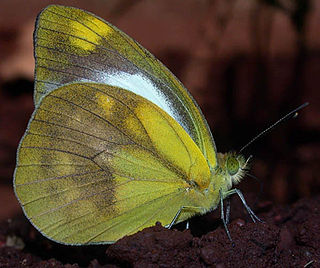
Cepora nadina, the lesser gull, is a small to medium-sized butterfly of the family Pieridae, that is, the yellows and whites. The species was first described by Hippolyte Lucas in 1852. It is native to Sri Lanka, India, Myanmar, Hainan, and southeast Asia.

Acronicta pruinosa is a moth of the family Noctuidae. It is found in Sri Lanka, the Himalaya, east to Japan and Taiwan south to Myanmar and Peninsular Malaysia, Borneo, Java and New Guinea.

Eucyclodes gavissima, the Oriental orange banded green geometer moth, is a species of moth of the family Geometridae described by Francis Walker in 1861. It is found in the Indian subregion, Sri Lanka, Bhutan, western China, Taiwan, Sumatra and Borneo.

Koyaga virescens is a moth of the family Noctuidae first described by Shigero Sugi in 1958. It is found in Japan and Taiwan.

Pseudodeltote formosana is a species of moth of the family Noctuidae first described by George Hampson in 1910. It is found in Taiwan.
Pseudodeltote brunnea is a species of moth of the family Noctuidae first described by John Henry Leech in 1889. It is found on the Japanese islands of Hokkaido, Honshu, Shikoku and Kyushu.

Pseudodeltote coenia is a species of moth of the family Noctuidae first described by Charles Swinhoe in 1901. It is found in Taiwan.

Pseudodeltote subcoenia is a species of moth of the family Noctuidae first described by Alfred Ernest Wileman and Richard South in 1916. It is found in Taiwan.
Protodeltote wiscotti is a species of moth of the family Noctuidae first described by Otto Staudinger in 1888. It is found in the Russian Far East and Japan.
Protodeltote distinguenda is a species of moth of the family Noctuidae first described by Otto Staudinger in 1888. It is found in Korea, Taiwan and Japan.
Protodeltote inexpectata is a species of moth of the family Noctuidae first described by Ueda in 1984. It is found in Japan.
Micardia argentata is a species of moth of the family Noctuidae first described by Arthur Gardiner Butler in 1878. It is found in China, Korea and Japan.
Micardia pulchra is a species of moth of the family Noctuidae first described by Arthur Gardiner Butler in 1878. It is found in Korea and Japan.
Koyaga falsa is a species of moth of the family Noctuidae first described by Arthur Gardiner Butler in 1885. It is found in China, Korea and Japan.
Koyaga numisma is a species of moth of the family Noctuidae first described by Otto Staudinger in 1888. It is found in Russia, China, Korea and Japan.
Koyaga senex is a species of moth of the family Noctuidae first described by Arthur Gardiner Butler in 1881. It is found in Japan.

Koyaga viriditincta is a species of moth of the family Noctuidae first described by Wileman in 1915. It is found in Taiwan.

Xylostola indistincta is a species of moth of the family Noctuidae first described by Moore in 1882. It is found from the Indo-Australian tropics of India, Sri Lanka to New Guinea.

Maliattha signifera is a species of moth of the family Noctuidae first described by Francis Walker in 1858. It is found in south-east Asia, including China, India, Japan, Taiwan, Korea and Thailand as well as in Australia (Queensland).

Ichneutica ceraunias is a moth of the family Noctuidae. It is endemic to New Zealand. This species is found from the central North Island to the bottom of the South Island. Hosts of the larvae are species of Chionochloa and Festuca. This colourful moth is variable in appearance and can be mistaken for Ichneutica dione. Adults are on the wing from October to February.










